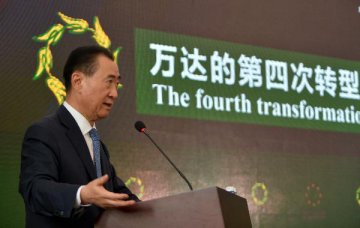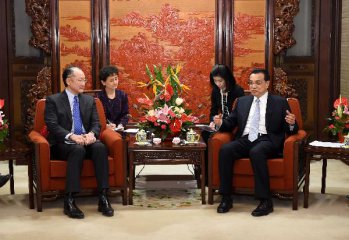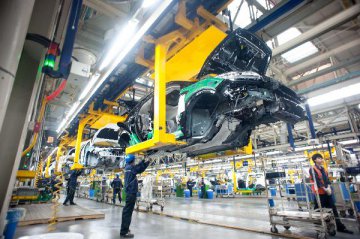
The National Bureau of Statistics on Feb. 29 issued Statistical Communiqué of the People's Republic of China on the 2015 National Economic and Social Development (hereinafter the “Communiqué”), which indicated that the economic restructuring has made steady progress in 2015 and coordinated development has achieved remarkable results. Experts told reporter from the Economic Information Daily that China’s economy is likely to continue to dip in 2016, but a rebound is expected in the second half. And attentions should be paid to multiple risks that may appear during the process of implementing supply-side reform.
In his interpretations to the Communiqué, the deputy director of the National Bureau of Statistics Xu Xianchun says that the economic restructuring in 2015 pointed to four directions: 1) the service industry continued to make greater contribution to the economy. The value added of the service industry throughout the year increased by 8.3 percent from the previous year, 2.3 percentage points higher than the secondary industry, accounting for 50.5 percent of China’s GDP; 2) Consumption played a greater role in boosting economic growth. The ultimate consumption of the year contributed 66.4 percent to economic growth, up 15.4 percentage points than the previous year. Meanwhile, the investment structure has been optimizing. During the year, the investment in infrastructure and high-tech industry grew by 17.2 and 17.0 percent respectively from the previous year; 3) the level of urbanization continues to rise. The urbanization rate of permanent residents by the end of the year reached 56.1 percent, 1.33 percentage points higher than the previous year. In the meantime, the income gap between rural and urban residents continue to narrow, with income of urban residents 2.73 times higher than rural residents, 2 percent down from the previous year; 4) Major economic indicators of central and western China grew faster than the East. During the year, the growth rates of value added of industries above the designated scale in central and western China are 0.9 and 1.1 percentage points higher than that of the East; total fixed asset investment in central China grew 2.8 percentage points faster than the East.
For the economic development in 2016, economists interviewed generally believe that China’s economy will continue to dip in the year. There’s huge pressure on stabilizing growth, and the economy is likely to worsen in the first half and rebound in the second half.
“China’s economy is still running in the downward cycle, and has not yet reached the bottom. It will continue to decline in 2016,” said Fan Gang, a member of the central bank's monetary policy committee and Zhu Jianfang, chief economist with CITIC Securities.
When the economy continues to dip, China faces challenges to stabilize growth in 2016. “Stabilizing growth is the core objective of macro-economic restructuring in 2016, but the pressure is really big,” in the eyes of Li Daokui, director of Tsinghua University's Center for China in the World and Liu Yuanchun, executive director of the national development and strategic research Institute of Renmin University. Firstly, China has to push forward supply-side structural reform, despite there are lots of impacts from the globe; secondly, the country also has to clean up “zombie enterprises”, clear debts and obliterate overcapacity, which requires the shut-down of many enterprises and may cause massive unemployment. Thirdly, globalization dividend, industrialization dividend, system dividend and China’s demographic dividend are all diminishing, but new industrial structure has not yet fully emerged.
Experts indicated that if destocking housing inventory and cutting excessive production capacity are accelerated and real estate investment recovers timely, China’s economy is likely to rebound in the second half year. The only divergence is whether it will be moving along “V” shape or “L” shape.
Li believes that the current economic downturn may see a turnaround in the middle of 2016 and recover by the end of the year. Real estate investment, however, is a crucial factor deciding whether China’s economy can realize “V-shaped” rebound or not.
Vanessa:
However, Teng Tai, head of Winbro Economic Research Institute, indicated that China’s economy would bottom out and then recover in 2016. But different from the first quarter in 2009, the trend of bottoming out in 2016 will go like an L shape instead of a V-shaped reverse due to lacking impetus for fast rebound and recovery.
Several experts remind that this year is an important period to fully implement the supply-side reform and various risks should be particularly prevented when promoting the supply-side reform to avoid partial or overall risks. For example, reducing capacity and “zombie enterprises” will inevitably lead to unemployment problem. At present, employment pressure has emerged. The pressure in many traditional manufacturing industries in Northeast China, especially in the enterprises engaged in excavation, mining and coal industries, has threatened the survival of ordinary people and is not just merely a simple employment problem any more, said Niu Li, deputy director of the National Information Center's economic forecast department.
Besides, the financial systematic risk should be prevented from developing into a hidden danger for economic development. The government should focus on the management structure of financial field and keep away policy mismatch in 2016, Teng indicated. There were many subjective factors for the occurrence of money shortage in 2013 and stock plunge and exchange rate disaster in 2016 and these factors did not disappear in 2016. Carrying out incautious policies, such as introducing the registration-based IPO system in a fast pace or promoting renminbi’s internationalization and exchange rate market without meeting the actual conditions, will trigger unnecessary risks.
In addition, it should also prevent private debt risk. The biggest risk in 2016 may be the increase in private debt chain interruption, which will cause panic in the market, according to Li Xunlei, chief economist of Haitong Securities Company Limited.
Translated by Adam Zhang and Vanessa Chen
























Latest comments